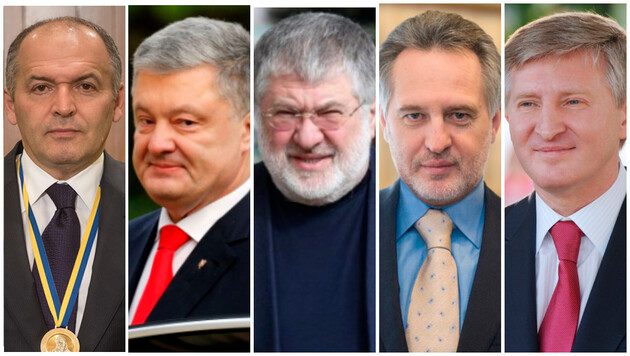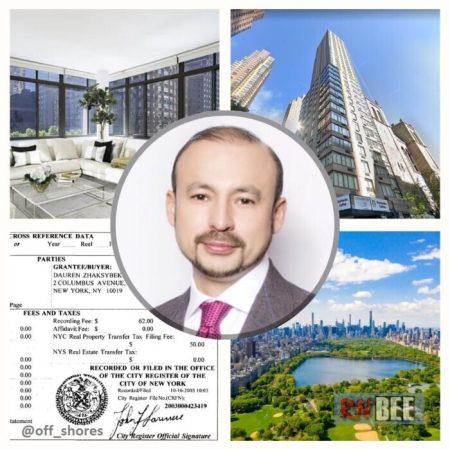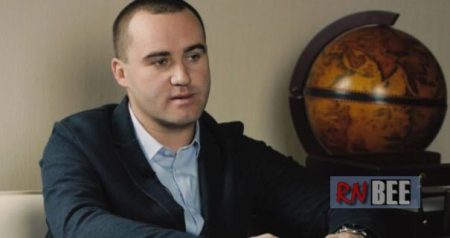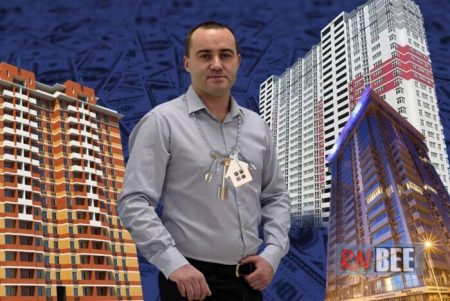Oligarchy of Ukraine. Origin and development
Information from the report of the Center for Economic Strategy called 'Oligarchic Ukrainian Capital'.
Oligarchs have a significant impact on Ukraine's economy. At the start of 2021, they controlled 36 out of the 100 largest companies in Ukraine. They oversee industries like electricity, natural gas, and fuel, which affects other businesses and private consumers. They acquire entire chains of businesses, limiting their growth and variety.
We've selected these businessmen for calculations, but we'll focus on the wealthiest ones in the next sections.
Oligarchy of Ukraine. Origin and development
By the beginning of 2021, oligarchs held 11% of all Ukrainian business assets. Their portion of total revenue and employment was even smaller, at 10% and 6% respectively. However, this share is much higher in certain industries, such as metallurgy, coal and oil production, electricity and natural gas distribution, chemicals, oil and coke production.
They were not able to dominate the agricultural sector (excluding certain capital-intensive types), IT, retail, and other competitive industries. They attempted to do so with varying results. For instance, Rinat Akhmetov once shut down a retail network, sold gas stations, insurance and telecommunications companies. The only significant exception is the banking sector, where the largest and most successful player (PrivatBank) was once owned by the oligarchs, and several other large banks are also owned by them.
Oligarchy of Ukraine. Origin and development
Oligarchs frequently abuse their monopoly position. Nearly every Ukrainian oligarch's business has come under scrutiny by the Antimonopoly Committee, and oligarchs are responsible for about 40% of the committee's fines (for more details, see the antimonopoly policy section). According to initial estimates by the Antimonopoly Committee of Ukraine in 2016, monopoly rent in Ukraine accounts for 10-20% of GDP.
DYNAMICS
Over the past decade, the influence of oligarchs on the Ukrainian economy has declined. Since reaching its peak in 2011, their share in the assets, revenues, and workforce of Ukrainian companies has decreased by approximately half. The first reason is the loss of some assets in the eastern regions and Crimea. The second and main reason is the slower growth of their businesses compared to the rest of the economy.
Oligarchy of Ukraine. Origin and development
The rankings of oligarchs based on their wealth change over time. While some oligarchs are strengthening their positions, others are exiting the scene. This indicates that there are factors leading to their loss of business.
Oligarchy of Ukraine. Origin and development
The geographical distribution of oligarchs' assets is distinct. Most oligarchs aim to dominate specific areas in order to achieve autarky, making it easier to control the local authorities.
Oligarchy of Ukraine. Origin and development
This has had a negative impact on other businesses in these areas: they did not have access to government funds, lost their best employees, and local regulations did not benefit them. The five regions with the highest proportion of oligarchs experienced an average growth rate of 2% from 2004-2013, while others had double that – 4%. (East).
Oligarchy of Ukraine. Origin and development
Ukrainian oligarchy: CAPITAL CREATION
Most of the assets that made the wealth of the oligarchs were actually created by other people. Out of the 200 largest companies, 20% were established before the Soviet era, 62% were formed during the Soviet times, and only 18% were founded during Ukrainian independence.
The old assets were obtained during different waves of privatization. According to our calculations, investors paid slightly more than all the other assets did over the past 25 years (around $6.5 billion), compared to Mittal Steel paying $4.8 billion for Kryvorizhstal in 2005.
Oligarchy of Ukraine. Origin and development
Comparison of prices with the assets of individual enterprises also reveals that in most cases the oligarchs did not pay excessively to acquire these assets. On average, the winning bid was only 3% higher than the remaining value of the company's long-term assets. Auctions often involved or were followed by scandals (see the next section).
Oligarchy of Ukraine. Origin and development
PRIVATIZATION SCANDALS
One of the most notable privatization scandals is linked to the privatization of Kryvorizhstal, a metallurgical plant, the largest enterprise in the industry in Ukraine. Established in 1934, Kryvorizhstal remained state-owned until the 2000s, when then-President Leonid Kuchma, at the end of his second term, decided to privatize the plant.
In June 2004, the State Property Fund sold Kryvorizhstal to the investment and metallurgical union, which became a joint union of Rinat Akhmetov and Viktor Pinchuk, for $804 million. The auction received criticism for its process (foreign bidders were intentionally excluded from participating, and an absurd requirement for three years of experience in the Ukrainian metallurgical market was introduced during negotiations), as well as the sales proceeds. Viktor Pinzenyk, who later became Finance Minister, noted at the end of 2004 that the real price of the plant reached 5-6 billion dollars. Consequently, in October 2005, the plant was re-privatized at an open auction for $4.8 billion by Mittal Steel, the metallurgical giant. The reprivatization of Kryvorizhstal became the most successful privatization in terms of budget revenues.
In 2004, the controversial privatization of the UkrRudProm concern began, involving a dozen raw material extraction companies for metallurgy. These enterprises, including six mining and processing plants, were privatized through questionable agreements between Kolomoisky and Akhmetov.
The agreements between the oligarchs came to light during the trial in London between Pinchuk and the Privatovites. Pinchuk sought compensation from Kolomoisky and Bogolyubov for allegedly unmet obligations to privatize the Kryvyi Rih iron ore plant in favor of Pinchuk. The dispute ended with a settlement agreement, but the fact that a significant state concern was privatized by several oligarchs as a result of non-transparent agreements remains a fact.
Later, the law that permitted only owners of 25% of shares to participate in the final privatization of Ukrrudprom assets, was attempted three times to be declared unconstitutional. Recently, at the end of November 2022, it became known that the Constitutional Court of Ukraine started to consider the third such submission.
The following year, 2005, was a significant time in the privatization history of another company – the Severodonetsk Azot Association, one of the biggest chemical plants in Ukraine. Just a few days before the end of 2004, on December 26, the saga of its privatization concluded and 60% of the company's shares became the possession of an American businessman of Ukrainian descent Alex Rovt in exchange for a commitment to invest 120 million dollars in the modernization of production.
In 2005, an effort was made to acquire the plant through the courts in favor of another contender, Konstantin Zhevago, whose interests were described as supported by the post-Maidan Prime Minister Yulia Tymoshenko. However, in September 2005, Tymoshenko's government was removed, and Zhevago's attempt to take over the plant failed. In 2012, all 100% of the shares were purchased by Dmitry Firtash, who concentrated most of the country's major chemical enterprises in his control.
Finally, 2005 became the year of the battle for the Nikopol Ferroalloy Plant (NFZ). Privatized in 2003 by Viktor Pinchuk’s entities for UAH 410 million, the plant found itself at the center of the conflict between the oligarch and the Privat group. In 2005, legal complications began with the goal of returning to state ownership.
The former leadership of the State Property Fund accused Pinchuk, son-in-law of then President Kuchma, of manipulating privatization tenders. After a lengthy legal process, several conflicting court decisions, and secret agreements between the parties in the conflict, the NFZ ultimately came under the control of the Privat group.
After 2005, the term “re-privatization” went out of fashion for a while.
>After several resales, the SCM group of oligarch Rinat Akhmetov became the owner of the company. A few years after the Revolution of Dignity, in 2017, the State Property Fund attempted to regain ownership of Ukrtelecom through the court, terminating the initial privatization agreement of 2011. The SPFU accused ESU of failing to adhere to the terms of the sale and purchase agreement. In the end, the court rejected the Fund's claim, and Ukrtelecom is still owned by Akhmetov.
In Ukrainian realities, oligarchs do not always have to purchase enterprises in order to essentially own them. Sometimes they use their political influence to gain control over businesses that remain state-owned. This occurred, specifically, with the Sumykhimprom chemical plant, led by Igor Lazakovich in 2010, Dmitry Firtash, manager of one of the companies, who built his own chemical empire.
Since then, the main suppliers of the plant have been companies associated with Firtash.23 The State Property Fund has repeatedly announced its intention to privatize Sumykhimprom. An obstacle to this is the procedure for reorganizing the enterprise, introduced in 2012 and still in force today, allowing the management of Sumykhimprom to block the privatization process through the court.
Ukraine's Oligarchy: "STARTUPS"
There were only a few big businesses in Ukraine not owned by powerful people, but built from the ground up. We will discuss those companies here. The biggest of these companies in terms of assets is Dneproprostal, a metallurgical plant in Dnipro, part of the Interpipe group owned by Viktor Pinchuk. It cost $700 million to build and started operating in October 2012. This is the first and only metallurgical plant built during Ukraine's independence.
The major new businesses of the powerful individuals include seven companies linked to Rinat Akhmetov. The largest is Astelit LLC, a mobile telecommunications company operating under the life:) brand. It was established in 2005 and became one of the top three mobile operators in Ukraine. In 2015, Akhmetov sold Astelit LLC to the Turkish operator Turkcell, which changed the brand name to lifecell and renamed the company Lifecell LLC.
Akhmetov's other six companies operate wind and solar power plants and are part of the DTEK group.
The Nika-Tera seaport in Nikolaev, owned by Dmitry Firtash, is the last on the list of the major companies. It started being built in 1995 on a swampy area near an underloaded railway station. In 2020-2021, Nika-Tera was among the top three largest terminals for grain transshipment. Russian troops fired rockets at the port in early June 2022, causing a large warehouse to burn down.
Ukraine's Oligarchy: USE OF OFFSHORE
Offshore companies are a useful way to hide or safeguard property. About 1,500 Ukrainian citizens were mentioned in documents from the Panamanian law firm Mossack Fonseca, leaked in 2016. The list included politicians, officials, entrepreneurs, and even music and sports stars.
On average, Ukrainian powerful individuals own 60% of their assets through other countries. Some do it officially, openly, and transparently, naming foreign companies clearly (for example, Metinvest B.V., DTEK Power B.V., etc.). Others create a network of companies with amusing names. The most popular places for this are Cyprus, Luxembourg, the Netherlands, and Switzerland. Only Medvedchuk owned part of his assets through Russia.
The powerful people use foreign companies for various reasons. The main reasons used to be the chance to hide (which no longer works due to the requirement to show the ultimate beneficiary) and save on taxes (which also partly doesn't work due to changes in tax laws).
So now, the only real reason left is to protect property. In case of disagreements, the case will be heard in a court of another country. But this actually means that they do not want the Ukrainian judicial system to improve.
Ukraine's Oligarchy: Origin and Development
Ukraine's Oligarchy: COOPERATION AND COMPETITION
While powerful individuals are usually independent and more competitive than cooperative, there have been times when they have worked together in an alliance for situational benefits, control of the media or political parties, or to strengthen business efforts.</p
There have been examples of cooperation between Ukrainian rich and powerful people, both lasting and temporary. One interesting example is the buying of Kryvorizhstal, the biggest metal factory in Ukraine, in 2004, when Rinat Akhmetov and Viktor Pinchuk worked together and purchased the factory for $804 million. However, this cooperation did not last long. Kryvorizhstal was sold again in 2005 for $4.8 billion, and the money was given back to the previous owners. The rich and powerful people disagreed with the court's decision.
In 2018, the European Court of Human Rights turned down a demand to pay them $12.9 billion.
Another kind of collaboration is a long-term partnership. For instance, there is Metinvest, a mining and metal group owned by Rinat Akhmetov and Vadim Novinsky. They have been partners for 15 years. Novinsky once said that Akhmetov is the best partner he has ever had. In 2011, the rich and powerful people established the HarvEast agricultural holding together.
Sometimes shared interests lead rich and powerful people to work together in politics. For example, the pro-Russian Opposition Bloc was a political party that represented the interests of Rinat Akhmetov and Dmitry Firtash until 2017, when they went their separate ways.
The media are closely connected with politics. Thus, collaborations can also be seen in this area, especially between rich and powerful people with similar political opinions. The first example is Inter Media Group, which is co-owned by Dmitry Firtash, Valery Khoroshkovsky, and Sergey Levochkin. Their main asset, the Inter TV channel, was once the most popular TV channel in Ukraine, but since 2012 its ratings have started to fall. The second example is the 1+1 Media Group, owned by Igor Kolomoisky, Igor Surkis, and Oksana Marchenko (Viktor Medvedchuk's wife). The 1+1 TV channel is one of the most popular in Ukraine.
If arguments cannot be settled privately, the rich and powerful people make their disagreement public. Many of these disputes are related to privately owned companies. The most well-known conflict is between Viktor Pinchuk, Igor Kolomoisky, and Gennady Bogolyubov over the Nikopol Ferroalloy Plant and the Krivoy Rog Iron Ore Plant. Disagreements in British courts related to the latter went on for more than 10 years. Eventually, the parties were able to come to an agreement. Pinchuk got two very expensive properties in London, while the plant stayed with the Privat group.
LOSSES OF OLIGARCHS THROUGH THE WAR
The direct military invasion of the Russian Federation on the territory of Ukraine, which began on February 24, 2022, led to extensive damage to physical assets. According to the Russia Will Pay project, in which the Central Economic Commission takes part, the total cost of direct losses is nearly $130 billion, with about $10 billion from the industry. More than $4.5 billion of this amount comes specifically from the assets of the rich and powerful people. There is also damage in the energy sector, but it's difficult to give exact numbers.
The activities of the rich and powerful people during a full-scale war
Late in the evening on February 23, 2022, many people hurried to the building of the Office of the President of Ukraine. They were invited by Zelensky himself, and among them were leading Ukrainian businessmen. The President invited them to discuss the threat of war facing Ukraine at that time. His main point was that it was very important to save the economy, and he wanted to reassure the businessmen that it was in their interest to continue to work as usual.
As we now know, this evening was on the eve of a full-scale Russian invasion of Ukraine.
It is also known that among the guests were some of the leading Ukrainian oligarchs, in particular, Rinat Akhmetov, Viktor Pinchuk, Vadim Novinsky, Gennady Bogolyubov, Sergei Tigipko, Igor and Grigory Surkis. Their actions during the all-out war and other oligarchs are likely to significantly influence their public image and perception in post-war Ukraine. The image could even improve as their communication focuses on how they help the country, as well as how they and their workers suffer.
Most oligarchs use their status and wealth to help Ukraine win in the war. There are a lot of them, which can be explained not only by the patriotic feelings of the oligarchs (which is natural), but also by the desire to save their assets, which the Russians are likely to demand for the defeat of Ukraine. Most Ukrainian oligarchs provide financial and other support to the Armed Forces of Ukraine, the authorities and society.
Some oligarchs, such as Kolomoisky, Bogolyubov and Novinsky, remained indifferent and did not support Ukraine in any way or did not publicly declare such support.
p>
THE PREPARED:
Dmitry Goryunov, Senior Economist
Bogdan Prokhorov, Economist
Maxim Samoylyuk, Junior Economist
Vyacheslav Nozdrin, Communications Director
Zelensky’s anti-oligarchic law was put on hold, but Akhmetov’s factories are being taken away
Is this definitely deoligarchization?
Russian oligarchs owned oblenergos in Ukraine: to whom were the assets registered and how did they work




